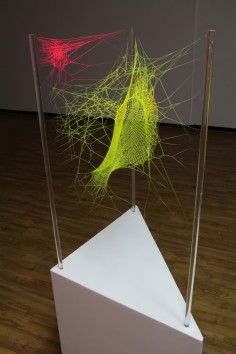Michael Anthony Simon
Pink and Yellow in Excited States
source: highlike
Work: Lacquer on Nephila Clavata spider web, 2011.
.
.
.
.
.
.
.
source: beautifuldecay
In the fall of 2009 artist Michael Anthony Simon left Chicago behind, and moved to the countryside of Korea. He wanted to experience a new place and culture that would hopefully inform a fresh body of work that could exist beyond the constraints of the western art world. What initially began as a “high-lighting” of different natural elements quickly developed into a series with far broader implications. Simon came across a huge spider web in the forest one day while choosing the location for his next piece, and began experimenting with that as the next logical progression in a rapidly evolving body of work. What he couldn’t have counted on at the time was where this accidental discovery would take him. Fast-forward six months, and Simon’s studio has become a factory of sorts. Many skilled workers meticulously build elaborate concentric structures between plastic rods secured atop various geometric plinths. The presence of these assistants would not be so surprising, if they were human. Through many months of trial and error, Simon has developed a method that allows him to harness the inherent artistry of what many consider to be one of nature’s most horrifying creatures. First, he locates and captures a particularly industrious breed of spider in the surrounding areas, and then (with a bit of guidance) allows them to do what spiders do best – build webs. Once completed, he returns the spiders to where he found them, and begins coating the webs in countless layers of misted lacquer. The process is unlike any I’ve ever seen, and the result is beautiful. Sculptures, as much about formalism as they are about industrialized labor. The work is part of a broader dialogue, one that exists outside of conventional eastern or western boundaries, and it is this universal approach to art making that sets the work of Michael Anthony Simon apart from many of his contemporaries. With a few major institutional shows under his belt in Korea, an upcoming trip to the States, and the official release of a new website slated for the Summer of 2012 – I can guarantee you that we will be seeing much more of this artist’s work in the years to come.
.
.
.
.
.
.
.
.
source: bifuteki
Look at this. Spider-Man has nothing on these little Picasso-like arachnids. Artist Michael Simon came across some silk spinning spiders and figured he could do something with these talented little creatures. Mother Nature really is the greatest artist ever, check out some more spider action in our gallery below.
.
.
.
.
.
.
.
.
source: insolite-2tout2rien
Anthony Michael Simon, artiste originaire de Chicago, s’est spécialisé dans des sculptures un peu particulières. Disons qu’il ne sculpte pas vraiment en fait puisqu’il utilise des toiles d’araignées qu’il peint.Des toiles d’araignées colorées. Il pulvérise sur les fragiles tissage une couleur et une couche de protection.
.
.
.
.
.
.
.
.
source: churisco
O artista Anthony Michael Simon, de Chicago, enxergou algo interessante nas teias de aranha. Com a ajuda de talentosos auxiliares de 8 patas (as temidas aranhas) e suas armadilhas, Anthony aplicou um spray de revestimento para proteger as teias frágeis e adicionou cor para dar um toque artístico, resultando nas belas e diferentes esculturas de teias de aranha.
.
.
.
.
.
.
.
.
source: portalquepasa
¿Puede creer que estas coloridas mallas de colores, son en realidad telas de araña?. En un viaje por los bosques de Corea, el escultor Anthony Michael Simon, se topó con una enorme tela de araña, inmediatamente se preguntó si podría tomar algunas arañas y hacer que tejieran sus telas de forma natural en su estudio. Por suerte para nosotros, ¡funcionó!…
Las obras son verdaderamente excepcionales, en su construcción y preservación. El artista rocía una capa protectora sobre las frágiles redes y luego le añade color. Las estructuras multicolores están sostenidas por varas plásticas, lo que permite al espectador ver la complejidad de cada pieza. Los colores fluorescentes también añaden un toque futurista a las esculturas.


